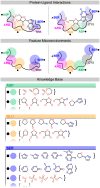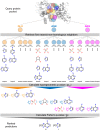Knowledge-based fragment binding prediction
- PMID: 24762971
- PMCID: PMC3998881
- DOI: 10.1371/journal.pcbi.1003589
Knowledge-based fragment binding prediction
Abstract
Target-based drug discovery must assess many drug-like compounds for potential activity. Focusing on low-molecular-weight compounds (fragments) can dramatically reduce the chemical search space. However, approaches for determining protein-fragment interactions have limitations. Experimental assays are time-consuming, expensive, and not always applicable. At the same time, computational approaches using physics-based methods have limited accuracy. With increasing high-resolution structural data for protein-ligand complexes, there is now an opportunity for data-driven approaches to fragment binding prediction. We present FragFEATURE, a machine learning approach to predict small molecule fragments preferred by a target protein structure. We first create a knowledge base of protein structural environments annotated with the small molecule substructures they bind. These substructures have low-molecular weight and serve as a proxy for fragments. FragFEATURE then compares the structural environments within a target protein to those in the knowledge base to retrieve statistically preferred fragments. It merges information across diverse ligands with shared substructures to generate predictions. Our results demonstrate FragFEATURE's ability to rediscover fragments corresponding to the ligand bound with 74% precision and 82% recall on average. For many protein targets, it identifies high scoring fragments that are substructures of known inhibitors. FragFEATURE thus predicts fragments that can serve as inputs to fragment-based drug design or serve as refinement criteria for creating target-specific compound libraries for experimental or computational screening.
Conflict of interest statement
The authors have declared that no competing interests exist.
Figures






Similar articles
-
In silico fragment-mapping method: a new tool for fragment-based/structure-based drug discovery.J Comput Aided Mol Des. 2018 Nov;32(11):1229-1245. doi: 10.1007/s10822-018-0160-8. Epub 2018 Sep 8. J Comput Aided Mol Des. 2018. PMID: 30196523
-
Predicting target-ligand interactions using protein ligand-binding site and ligand substructures.BMC Syst Biol. 2015;9 Suppl 1(Suppl 1):S2. doi: 10.1186/1752-0509-9-S1-S2. Epub 2015 Jan 21. BMC Syst Biol. 2015. PMID: 25707321 Free PMC article.
-
Ligand specificity, privileged substructures and protein druggability from fragment-based screening.Curr Opin Chem Biol. 2011 Aug;15(4):469-74. doi: 10.1016/j.cbpa.2011.02.020. Epub 2011 Mar 14. Curr Opin Chem Biol. 2011. PMID: 21411360 Review.
-
Generalized modeling of enzyme-ligand interactions using proteochemometrics and local protein substructures.Proteins. 2006 Nov 15;65(3):568-79. doi: 10.1002/prot.21163. Proteins. 2006. PMID: 16948162
-
The SeeDs approach: integrating fragments into drug discovery.Curr Top Med Chem. 2007;7(16):1568-81. doi: 10.2174/156802607782341109. Curr Top Med Chem. 2007. PMID: 17979768 Review.
Cited by
-
Identification of Histamine H3 Receptor Ligands Using a New Crystal Structure Fragment-based Method.Sci Rep. 2017 Jul 6;7(1):4829. doi: 10.1038/s41598-017-05058-w. Sci Rep. 2017. PMID: 28684785 Free PMC article.
-
Predicting fragment binding modes using customized Lennard-Jones potentials in short molecular dynamics simulations.Comput Struct Biotechnol J. 2024 Dec 23;27:102-116. doi: 10.1016/j.csbj.2024.12.017. eCollection 2025. Comput Struct Biotechnol J. 2024. PMID: 39816914 Free PMC article.
-
Combination therapeutics in complex diseases.J Cell Mol Med. 2016 Dec;20(12):2231-2240. doi: 10.1111/jcmm.12930. Epub 2016 Sep 7. J Cell Mol Med. 2016. PMID: 27605177 Free PMC article. Review.
-
A deep learning framework to predict binding preference of RNA constituents on protein surface.Nat Commun. 2019 Oct 30;10(1):4941. doi: 10.1038/s41467-019-12920-0. Nat Commun. 2019. PMID: 31666519 Free PMC article.
-
Ranking Enzyme Structures in the PDB by Bound Ligand Similarity to Biological Substrates.Structure. 2018 Apr 3;26(4):565-571.e3. doi: 10.1016/j.str.2018.02.009. Epub 2018 Mar 15. Structure. 2018. PMID: 29551288 Free PMC article.
References
-
- Pammolli F, Magazzini L, Riccaboni M (2011) The productivity crisis in pharmaceutical R&D. Nat Rev Drug Discov 10: 428–438. - PubMed
-
- Scannell JW, Blanckley A, Boldon H, Warrington B (2012) Diagnosing the decline in pharmaceutical R&D efficiency. Nat Rev Drug Discov 11: 191–200. - PubMed
-
- Hopkins AL, Groom CR (2002) The druggable genome. Nat Rev Drug Discov 1: 727–730. - PubMed
-
- Bolton E, Wang Y, Thiessen PA, SH B (2008) PubChem: Integrated Platform of Small Molecules and Biological Activities. Annual Reports in Computational Chemistry. Washington, DC: American Chemical Society.
Publication types
MeSH terms
Substances
Grants and funding
LinkOut - more resources
Full Text Sources
Other Literature Sources

